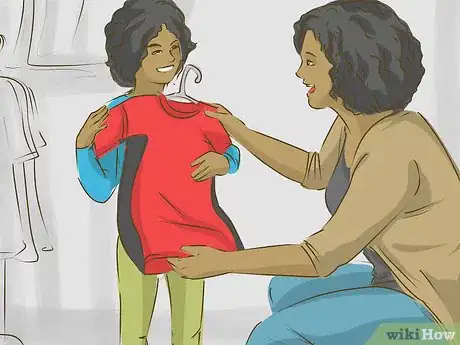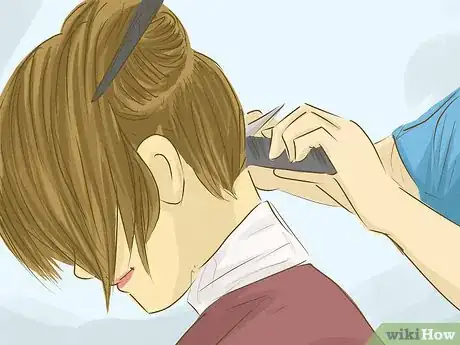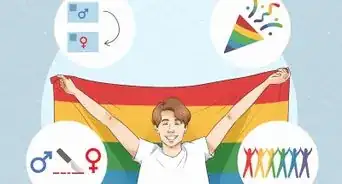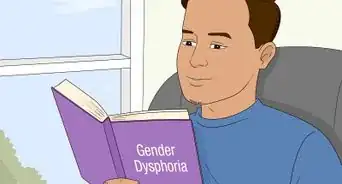This article was co-authored by Inge Hansen, PsyD. Dr. Inge Hansen, PsyD, is the Director of Well-Being at Stanford University and the Weiland Health Initiative. Dr. Hansen has professional interests in social justice and gender and sexual diversity. She earned her PsyD from the California School of Professional Psychology with specialized training in the area of gender and sexual identity. She is the co-author of The Ethical Sellout: Maintaining Your Integrity in the Age of Compromise.
There are 24 references cited in this article, which can be found at the bottom of the page.
This article has been viewed 89,248 times.
Gender dysphoria is when someone identifies as a gender other than the one they were assigned at birth – whether that gender is male, female, non-binary, genderfluid, or any other manifestation of gender. Dysphoria can present itself in many different ways, depending on the person and their circumstances. Though an official diagnosis of gender dysphoria must be made by a psychiatrist, there are many ways someone can experience gender dysphoria or gender-nonconforming behavior.
Steps
Identifying Gender Dysphoria
-
1Understand that gender dysphoria varies among people. While there are some general signs used to identify gender dysphoria, it's not cut-and-dry, and everyone experiences it differently. Some people identify their true gender in early childhood, whereas others don't recognize it until puberty or adulthood. Some people experience severe and distressing dysphoria, while others experience it minimally or not at all. There's no one "right" way for someone to experience dysphoria, so gender dysphoria can be difficult to identify, and it may take time to figure it out.[1] [2]
- Gender dysphoria can exist in anyone who's not cisgender, including nonbinary people.[3]
- If you're trying to determine whether you're experiencing gender dysphoria, you may find it beneficial to look at forums and social media sites for transgender and nonbinary people, read various people's experiences to see if you relate to them, and read articles such as How to Know if You Are Transgender.[4]
-
2Recognize childhood signs. It's not unusual for children to experiment with gender, such as by wanting to be called by another name during play. However, if a child consistently asserts that they are a gender other than the one they were assigned, or resists behavior or presentation associated with the gender they don't identify with, they may have gender dysphoria. Signs of gender dysphoria or gender variance in a child include:[5]
- A repeated desire to be the other sex or an assertion that they are the other sex
- A belief that their assigned sex will change on its own (e.g. thinking they'll grow a penis or that their penis will come off when they get older)
- Wanting to change their name to a name typically associated with another gender, or a gender-neutral name
- A preference for presenting as another gender (e.g. a child assigned male at birth who prefers long hair and wearing dresses, or a child assigned female at birth who prefers short hair and wearing gender-neutral clothing)
- Resistance or distress when made to present as a gender they don't identify with (such as a "girl" throwing a tantrum over having to wear a dress or a "boy" crying after having to get a haircut)
- Assuming the role of another gender in fantasy games or make-believe
- An intense desire to participate in the games and activities typical of another gender (such as an assigned-male child playing with Barbie and an assigned-female child playing contact sports)
- A preference for playmates of another gender
Advertisement -
3Identify signs in adolescence. Gender dysphoria often becomes more apparent during puberty, since hormonal changes and physical changes are occurring, and a preteen or teen who previously didn't question their gender identity may suddenly feel confused or distressed about the changes.[6] Signs of gender dysphoria in adolescence include:[7]
- Feelings of panic or severe discomfort concerning puberty and bodily changes (e.g. refusing to acknowledge or admit changes are occurring, refusing to look at their body, or becoming distressed or uncomfortable with body development, menstruation, or ejaculation)
- Discomfort or distress with certain forms of gender presentation, such as disliking long hair or certain types of clothing
- Increased bullying at school due to differences in acting out one’s perceived gender or lack of self-confidence
- Isolation from peers due to lack of connection or fear of bullying
- Depression and/or anxiety as a result of confusion over gender identity or not fitting in with peers
- Be aware that some adolescents may try to repress their true gender due to outside pressure, such as from family and peers, even if they previously expressed their true gender as a child.[8]
-
4Recognize signs in adulthood. Often, gender dysphoria remains hidden or unrecognized until adulthood due to the learned gender behaviors that are taught to both children and adolescents by their family and peers. Some signs of gender dysphoria in adults include:[9]
- A difference between the sex at birth and the gender the individual expresses or experiences
- Consistently identifying with a gender other than the one matching the sex they were assigned (for an official diagnosis of gender dysphoria, this must have been ongoing for at least six months)
- Constant daydreaming or "what if..." thoughts about being another gender
- Wanting to be treated as another gender, or disliking being treated as the gender others perceive them as (e.g. being uncomfortable when addressed as "sir" or "ma'am")
- Wanting to remove, alter, or hide their sex characteristics (however, this is not present in all transgender or nonbinary people)
- The individual may feel that they act in ways typical of another gender.
- If gender dysphoria has been deeply repressed or buried, it may have resulted in mental health problems. Take note of any history of anxiety or depression, self-injurious behavior, or substance abuse, and whether these problems lessen or even disappear when they present as their true gender; these can be subtle indicators of dysphoria.[10]
- Everyone is different, and there are many ways to experience gender dysphoria. Sometimes it centers around certain body parts, such as disliking having breasts or a penis, and other times it's more focused around the roles and behaviors associated with one's assigned gender.[11]
-
5Take note of gender euphoria, too. Gender dysphoria can be difficult to identify, and some people don't experience it;[12] however, many transgender or nonbinary people experience gender euphoria, which is described as positive feelings when their true gender is affirmed and validated. Even if the person doesn't feel their assigned sex is wrong, they may feel that presenting as a different gender is right, instead.[13] Some signs of gender euphoria are:[14]
- Feeling happy or excited when addressed as their true gender
- Feeling relieved after identifying their gender
- Joy or excitement when presenting in a way that aligns with their gender (e.g. wearing a bra or cutting their hair short)
- A feeling of peace with their body when transitioning socially or medically
Considering Treatments
-
1Consider the options for children. Since children haven't started puberty yet, transition is typically social in nature, and doesn't involve medical treatment. Children can use this time to explore their gender identity, see what they feel most comfortable with, and decide what they want to do about puberty as they get older.[15] Ways that gender dysphoria is treated in children include:[16]
- Social transition (i.e., letting the child choose their own name, pronouns, and gender presentation)
- Counseling from a licensed gender therapist
- Medical treatment for older children consists of puberty blockers, though these require parental or guardian consent. (Puberty blockers prevent any signs of puberty in the child, which can prevent gender dysphoria from worsening and give them time to explore their gender identity. However, they can be safely skipped.)
-
2Look at the options during adolescence. The preteen and teen years add additional options for someone seeking help for gender dysphoria. With permission from their parents or guardians, teens can take the step of hormonal and legal transition, if they choose to. During adolescence, options for treatment include:[17]
- Social transition (i.e., choosing a new name, changing pronouns, and presenting their gender how they choose)
- Legal changes, such as changing their legal name, and/or in some areas, the sex on their ID or birth certificate (all legal changes typically require parental or guardian consent)
- Therapy, whether for gender identity or for associated struggles (e.g. mental health or peer disapproval)[18]
- Medical treatment for teens includes puberty blockers and hormone replacement therapy (HRT). These require parental or guardian consent.
- Puberty blockers can prevent or slow puberty, preventing any sex characteristics from maturing (and making any potential future transition easier).
- HRT (estrogen for those assigned male at birth, and testosterone for those assigned female at birth) stimulates the puberty of their true gender. HRT is not all-or-nothing; transgender and nonbinary teens can start off on lower dosages of hormones so the effects aren't drastic.
-
3Consider the options during adulthood. After reaching adulthood, there are a wide range of options for treating gender dysphoria. Therapy is typically accessible regardless of where you live, though other treatments (such as hormone therapy, gender-affirming surgeries, and legal changes) may require notes from medical professionals to receive.[19] Treatment for gender dysphoria in adults includes:[20]
- Social transition (i.e., choosing a new name, set of pronouns, and presenting their gender as they wish)
- Therapy, whether for gender identity or for associated conditions such as depression[21]
- Legal changes, such as name changes, and/or in some areas, legal gender changes[22] (note that in some areas, legally changing your gender requires documentation of sex reassignment surgery)[23]
- Medical treatment for adults consists of hormone replacement therapy (HRT), sex reassignment surgery (SRS), and potentially some other surgeries dependent on gender identity (e.g. mastectomies or facial feminization surgery).[24]
- HRT (estrogen for those assigned male at birth, and testosterone for those assigned female) will put the body through puberty, giving them features of their true gender. Hormonal transition can be gradual or slight; individuals can take lower dosages of hormones so the changes aren't as rapid.
- There are many types of gender-affirming surgeries, such as breast removal or augmentation, and sex reassignment surgery. These surgeries will change the person's body to more closely match their gender identity.
Coping After Diagnosis
-
1Reflect on the treatment options if you've been officially diagnosed. Medical professionals will be able to give you references to counselors or doctors to continue treatment. The type of treatment you opt to pursue is completely up to you; regardless of your gender identity, there are treatment options available for you and you can pursue any of the ones that you feel will match what your gender looks like.
- You don't need to pursue medical transition unless you want to. Not all transgender or nonbinary people undergo surgery, and not all of them take hormones; it doesn't invalidate their gender identity. Talk with your doctor and your therapist to help you figure out what you would feel most comfortable with.
- It's okay to be uncertain or nervous about certain types of transition. You may have some hangups about starting hormones or undergoing surgery, and this is completely normal - it's a big decision to make. However, don't let a fear of regret hold you back - it's very uncommon for those who transition to regret it.[25]
- Many treatments depend on what type of medical insurance you have. Check your insurance policy to see if they cover services related to medical transition.[26]
-
2Consider counseling even if your diagnosis hasn't been done officially. If your diagnosis was not made by an official, or if you are self-diagnosed, your medical options are limited. However, therapy or counseling is always an option (assuming you have the means of access).
- If you are unable to access therapy or counseling, it can be recommended that you attempt to discover more about your preferred gender and find ways of enacting that gender in your everyday life. When you are in a safe place, enacting your preferred gender can be freeing and validating, and will help you understand yourself better and live a happier life.
-
3Support a child or teen through gender exploration.[27] If your child expresses or has been diagnosed with gender dysphoria, or is uncertain about their gender, one of the best things you can do is show them your support. Make sure they know you love them, and allow them the freedom to express their gender however they choose. Having support while exploring or transitioning is incredibly important for their health and well-being.[28]
- If they change their name and/or pronouns, call them by their new name and/or pronouns, and apologize and correct yourself if you slip up.
- Seek out gender-affirming therapy so that your child can figure out their identity.[29] (Gender-affirming therapy does not force your child into transitioning, it just gives them an outlet to figure out their gender.)[30] Avoid "conversion" or "reparative" therapy, as these types of "therapies" have proven ineffective and traumatic, and have resulted in suicide.[31] [32]
- The decision on whether to allow a teen to medically transition can be difficult on parents. Discuss with your teen whether they want to pursue this kind of transition, and if they do, why. Go with them to talk to their doctor about how puberty blockers and/or HRT will affect their body. While you're not obligated to consent to your teen's medical transition, hearing out their reasons will help you and them both with the decision.
- Don't express doubt to them, say that it's "just a phase", or say things like "but you didn't act like this as a child" or "you're too young to know". Gender identity is complex and confusing even to adults, and it can take awhile for someone to figure out their real gender identity. And in the unlikely event that it is temporary, your child will appreciate that you gave them the freedom to figure that out on their own.[33]
-
4Take care of yourself. Regardless of your gender identity and whether or not you transition in any form, it's very important to take good care of yourself. Make sure to do things like eat healthy, sleep, shower, and exercise.[34] While it may feel like it's easier to just stare at the ceiling all day, it's not good for your physical or mental health to do so.
- Spend some time outdoors, if possible - even if you don't want to go out in public, sitting out in the fresh air may help a bit.[35]
- If you have a lot of body dysphoria, there are ways to handle bathing while dysphoric, and you can try putting away or covering up mirrors if you don't want to look at yourself.
-
5Network with the LGBTQIA+ community, particularly the transgender community. Many of them have experienced what you are going through now, and can offer advice and support.
-
6Come out, if you want to. ‘Coming out’ to your friends and family is completely optional. If you feel unsafe coming out, do not do so. However, having a support group can be helpful in getting an official diagnosis, validating your gender identity, and living your preferred lifestyle.
- Asking friends and family to refer to you using your preferred gender and personal pronouns can be a validating experience and help to shape your gender identity. After coming out to friends and family, you will be more able to enact your preferred gender through dress, mannerisms, and other personal habits in a free space.
-
7Explore and express your gender as you see fit. Whether it's private or public, online or in-person, or subtle or drastic - give yourself the opportunity to test out various gender identities and expressions. Even if one form of gender expression doesn't suit you, another may make you feel more comfortable. How and when you present yourself is entirely up to you.
- Not everybody can safely express their gender - for example, maybe you live with transphobic family or roommates. However, there may be some more subtle ways you can express yourself. Can you grow or cut your hair to a different length, wear gender-neutral clothing, start or stop shaving, or start undertaking grooming or self-care routines of the gender you identify with (like moisturizing your skin or using clear nail polish)?
- Don't worry if you doubt yourself sometimes, don't know with total certainty what your gender is, or enjoy forms of gender expression that don't align with your true gender. Even transgender and nonbinary people who transition for many years, including medically, feel uncertain sometimes. It doesn't mean you're not "really" your gender.[36]
Expert Q&A
-
QuestionCan gender dysphoria go away?
 Inge Hansen, PsyDDr. Inge Hansen, PsyD, is the Director of Well-Being at Stanford University and the Weiland Health Initiative. Dr. Hansen has professional interests in social justice and gender and sexual diversity. She earned her PsyD from the California School of Professional Psychology with specialized training in the area of gender and sexual identity. She is the co-author of The Ethical Sellout: Maintaining Your Integrity in the Age of Compromise.
Inge Hansen, PsyDDr. Inge Hansen, PsyD, is the Director of Well-Being at Stanford University and the Weiland Health Initiative. Dr. Hansen has professional interests in social justice and gender and sexual diversity. She earned her PsyD from the California School of Professional Psychology with specialized training in the area of gender and sexual identity. She is the co-author of The Ethical Sellout: Maintaining Your Integrity in the Age of Compromise.
Clinical Psychologist Gender dysphoria often serves as an impetus to begin the transition process. Seek out ways to live in and express your gender when and wherever you can and still feel safe. It’s also extremely helpful to have people in your life who understand and validate your gender, whether that is a friend, therapist, colleague, family member, or even an online community.
Gender dysphoria often serves as an impetus to begin the transition process. Seek out ways to live in and express your gender when and wherever you can and still feel safe. It’s also extremely helpful to have people in your life who understand and validate your gender, whether that is a friend, therapist, colleague, family member, or even an online community. -
QuestionWhat should I keep in mind when considering a new name as a part of my transition?
 Inge Hansen, PsyDDr. Inge Hansen, PsyD, is the Director of Well-Being at Stanford University and the Weiland Health Initiative. Dr. Hansen has professional interests in social justice and gender and sexual diversity. She earned her PsyD from the California School of Professional Psychology with specialized training in the area of gender and sexual identity. She is the co-author of The Ethical Sellout: Maintaining Your Integrity in the Age of Compromise.
Inge Hansen, PsyDDr. Inge Hansen, PsyD, is the Director of Well-Being at Stanford University and the Weiland Health Initiative. Dr. Hansen has professional interests in social justice and gender and sexual diversity. She earned her PsyD from the California School of Professional Psychology with specialized training in the area of gender and sexual identity. She is the co-author of The Ethical Sellout: Maintaining Your Integrity in the Age of Compromise.
Clinical Psychologist There’s no one right or wrong way to select a new name. It’s always a good idea to choose something you believe will have lasting power, i.e. something you are likely to still like 30 years from now.
There’s no one right or wrong way to select a new name. It’s always a good idea to choose something you believe will have lasting power, i.e. something you are likely to still like 30 years from now.
References
- ↑ https://www.psychiatry.org/patients-families/gender-dysphoria/what-is-gender-dysphoria
- ↑ https://everydayfeminism.com/2015/06/these-5-myths-about-body-dysphoria-in-trans-folks-are-super-common-but-also-super-wrong/
- ↑ https://everydayfeminism.com/2015/06/these-5-myths-about-body-dysphoria-in-trans-folks-are-super-common-but-also-super-wrong/
- ↑ Inge Hansen, PsyD. Clinical Psychologist. Expert Interview. 19 November 2019.
- ↑ Le Huezey, MF (2013). “Gender identity disorder in children and adolescents”. Archives de pédiatrie: organe official de la Société française de pédiatrie, 20 (3), 318-322.
- ↑ https://www.psychiatry.org/patients-families/gender-dysphoria/what-is-gender-dysphoria
- ↑ Bevan, T. E. (2015). The Psychobiology of Transsexualism and Transgenderism: A new view based on scientific evidence. Santa Barbara, CA: ABC-CLIO, LLC.
- ↑ Bevan, T. E. (2015). The Psychobiology of Transsexualism and Transgenderism: A new view based on scientific evidence. Santa Barbara, CA: ABC-CLIO, LLC.
- ↑ American Psychiatric Association (2013). “Gender Dysphoria.” American Psychiatric Publishing. PDF.
- ↑ https://the-orbit.net/zinniajones/2013/09/that-was-dysphoria-8-signs-and-symptoms-of-indirect-gender-dysphoria/
- ↑ Inge Hansen, PsyD. Clinical Psychologist. Expert Interview. 19 November 2019.
- ↑ https://www.psychiatry.org/patients-families/gender-dysphoria/expert-q-and-a
- ↑ https://www.theguardian.com/world/2019/jan/26/the-joy-that-comes-from-embracing-trans-identity-shouldnt-be-so-rare
- ↑ https://everydayfeminism.com/2015/06/these-5-myths-about-body-dysphoria-in-trans-folks-are-super-common-but-also-super-wrong/
- ↑ Inge Hansen, PsyD. Clinical Psychologist. Expert Interview. 19 November 2019.
- ↑ Bevan, T. E. (2015). The Psychobiology of Transsexualism and Transgenderism: A new view based on scientific evidence. Santa Barbara, CA: ABC-CLIO, LLC.
- ↑ Goldberg, A.B. (2007, April 25). ’God Made a Mistake’ … Transgender Kids. ABC News.
- ↑ Yarhouse, M. (2015). Understanding Gender Dysphoria: Navigating transgender issues in a changing culture. Downers Grove, IL: InterVarsity Press.
- ↑ https://www.lambdalegal.org/know-your-rights/article/trans-changing-birth-certificate-sex-designations
- ↑ Bevan, T. E. (2015). The Psychobiology of Transsexualism and Transgenderism: A new view based on scientific evidence. Santa Barbara, CA: ABC-CLIO, LLC.
- ↑ American Psychiatric Association (2013). “Gender Dysphoria.” American Psychiatric Publishing. PDF.
- ↑ Ruppin, U., & Friedemann P. (2015). Long-Term Follow-Up of Adults with Gender Identity Disorder. Archives of Sexual Behavior, 44(5), 1321-1329.
- ↑ https://www.lambdalegal.org/know-your-rights/article/trans-changing-birth-certificate-sex-designations
- ↑ Inge Hansen, PsyD. Clinical Psychologist. Expert Interview. 19 November 2019.
- ↑ https://www.huffingtonpost.com/entry/myths-about-transition-regrets_b_6160626
- ↑ https://www.healthcare.gov/transgender-health-care/
- ↑ Inge Hansen, PsyD. Clinical Psychologist. Expert Interview. 19 November 2019.
- ↑ https://www.genderspectrum.org/explore-topics/parenting-and-family/
- ↑ Inge Hansen, PsyD. Clinical Psychologist. Expert Interview. 19 November 2019.
- ↑ https://www.huffingtonpost.com/entry/six-facts-about-affirming-therapy-for-youth_us_588639e0e4b08f5134b62325
- ↑ http://www.hrc.org/resources/the-lies-and-dangers-of-reparative-therapy
- ↑ http://time.com/3655718/leelah-alcorn-suicide-transgender-therapy/
- ↑ Inge Hansen, PsyD. Clinical Psychologist. Expert Interview. 19 November 2019.
- ↑ https://www.teenvogue.com/story/how-to-feel-like-a-girl-before-hormone-replacement-therapy
- ↑ https://medium.com/@danyroth/how-not-to-kill-yourself-a-handy-guide-if-you-cant-transition-89798e866a88
- ↑ https://everydayfeminism.com/2016/02/questions-trans-people-have/
- Gender identity disorder. (2012). In Mosby, Mosby’s dictionary of Medicine, Nursing & Health professions. Philadelphia, PA: Elsevier Health Sciences. Retrieved from http://search.credoreference.com.ezproxy.library.unlv.edu/content/entry/ehsmosbymed/gender_identity_disorder/0
- Gender identity disorder. (2011). In W. Dorland, Dorland’s illustrated medical dictionary. Philadelphia, PA: Elsevier Health Services. Retrieved from http://search.credoreference.com.ezproxy.library.unlv.edu/content/entry/ehsdorland/gender_identity_disorder/0
About This Article
Gender dysphoria is when a person identifies as a gender other than the one they were assigned at birth. Some common signs in adults include the desire to be treated as another gender, wanting to remove, alter, or hide sex characteristics such as breasts or tone of voice, and consistently identifying with a gender other than the one they were assigned. If someone has hidden or repressed their gender dysphoria, it can result in mental health issues. Issues such as anxiety, depression, substance abuse, and self-injurious behavior can also be indicators of gender dysphoria. For information about treatment options for gender dysphoria, keep reading.








-Step-2.webp)

















-Step-16.webp)















































